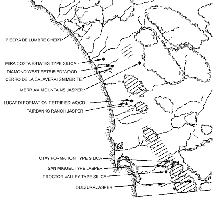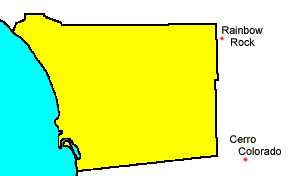| Type |
Other Designations |
Description |
| Cerro de la Calavera |
-- |
Opaque; grey, yellow-grey, green-grey, black; angular quartz grains |
| Diamond West |
Norwood Silica 5 |
Petrified wood; opaque to translucent; tan, brown, white, grey; good quality |
| Dulzura |
-- |
Opaque; yellow-brown to red; probably poor quality |
| Fairbanks Ranch |
Norwood Silica 3 |
Opaque; red; veins of white quartz and chalcedony; poor quality |
| Lucardi Formation |
-- |
Petrified wood; opaque to translucent; pink, tan, brown; good quality |
| Merriam Mountains |
Norwood Silica 4 |
Opaque; maroon, dull red; imperfections and fractures common; poor quality |
| Miracosta |
Norwood Silica 2; Flower et al. Chalcedony 2 |
Opaque; tan, brown, white; vugs and fractures common; poor quality |
| Otay Formation |
-- |
Opaque to translucent; brown, white, grey |
| Piedra de Lumbre |
Norwood Silica 1 ("Bonsall Type"); Flower et al. Chalcedony 1; True, Waugh, etc. ignimbrite |
Opaque; tan, cream, brown, pink; large subangular quartz grains diagnostic; good quality |
| Proctor Valley |
Cf. Norwood Silica 7 ("Encanto type") |
Opaque to translucent; commonly white but also orange, red, brown; poor quality |
| San Miguel |
-- |
Opaque; dull red |
 Notable attempts to identify and distinguish the sources of the cryptocrystalline silica found in San Diego County assemblages have been made by Douglas M. Flower, Darcy Ike, Linda Roth, and Susan Varner (1979), Richard H. Norwood (1979, 1982), and Andrew R. Pigniolo (1992, 1994). Pigniolo considered in detail the distinctiveness of material from the Piedra de Lumbre source on Camp Pendleton, which he found to be distinguishable from other local materials on the basis of each of three techniques: macroscopic observations, petrographic thin sections, and x-ray fluorescence trace element analysis.
Notable attempts to identify and distinguish the sources of the cryptocrystalline silica found in San Diego County assemblages have been made by Douglas M. Flower, Darcy Ike, Linda Roth, and Susan Varner (1979), Richard H. Norwood (1979, 1982), and Andrew R. Pigniolo (1992, 1994). Pigniolo considered in detail the distinctiveness of material from the Piedra de Lumbre source on Camp Pendleton, which he found to be distinguishable from other local materials on the basis of each of three techniques: macroscopic observations, petrographic thin sections, and x-ray fluorescence trace element analysis. Fine-grained, silica-rich toolstone, commonly termed "wonderstone," is also reported from two prehistoric quarry areas near San Diego County's eastern border: Rainbow Rock in northwestern Imperial County, and Cerro Colorado in northern Baja California (Eckhardt and Porcayo 2013; Pigniolo 1995). Archaeological specimens that visually seem to match the Rainbow Rock source have been reported from sites in Fallbrook and San Marcos, in western San Diego County.
Fine-grained, silica-rich toolstone, commonly termed "wonderstone," is also reported from two prehistoric quarry areas near San Diego County's eastern border: Rainbow Rock in northwestern Imperial County, and Cerro Colorado in northern Baja California (Eckhardt and Porcayo 2013; Pigniolo 1995). Archaeological specimens that visually seem to match the Rainbow Rock source have been reported from sites in Fallbrook and San Marcos, in western San Diego County.